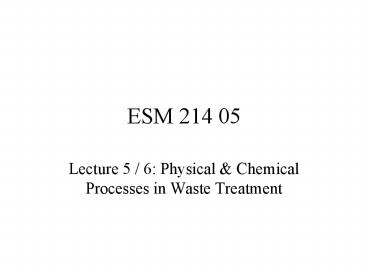ESM 214 05 - PowerPoint PPT Presentation
1 / 34
Title:
ESM 214 05
Description:
May precede Biological Treatment. e.g. flow equalization. e.g. preliminary and primary ... Dissolved Air Flotation Thickner (DAFT) Depth vs Surface Filtration ... – PowerPoint PPT presentation
Number of Views:54
Avg rating:3.0/5.0
Title: ESM 214 05
1
ESM 214 05
- Lecture 5 / 6 Physical Chemical Processes in
Waste Treatment
2
Physical Chemical Processes
- May precede Biological Treatment
- e.g. flow equalization
- e.g. preliminary and primary treatment
- May contribute to Biological Treatment
- e.g. precipitation in secondary clarifier
- e.g. aeration
- May follow Biological Treatment
- e.g. advanced treatment
3
Concept of Flow Equalization
- Dampen out diurnal fluctuations
- Divert toxics
- Balance loads
High flow diversion
Low flow return
Qi
Qi
4
(No Transcript)
5
Some physical and chemical processes used with
biological treatment are for combining
- -- mixing flocculation
- -- aeration
6
Often the purpose of, physical and chemical
processes is to separate
- -- solids from liquid
- -- dissolved chemicals from liquid
- -- gases from liquid
7
Separating Solids
- Settling
- Discrete particles
- Flocculants
- Precipitants
- Flotation
- Filtration
- Granular media
- Membrane
- Centrifugation
8
Discrete Particle Settling
- Modeled by Stokes law (p 363 ME)
- Spherical, homogeneous particles
- No flocculation
- Vc depth? (Q / V) Q/A overflow rate
- Only particles with velocity gt Vc are removed
- Grit removal 30 sec to a few minutes
- Primary sedimentation (clarification) 1000
g/sf-d
9
Example Primary clarification
- Circular or rectangular basins
- 1.5 to 2.5 hour detention time
- Significant removal of BOD (up to 45)
- Removal of TSS (up to 70)
- Fractionation of VSS from TSS
10
Flocculation
- Flocculation formation of aggregates that settle
- Can occur during settling
- May be helped by coagulants
11
Flocs in activated sludge.
12
Coagulants / Precipitants
Alum Al2(SO4)318H2O Aluminum chloride
AlCl3 Lime Ca(OH)2 Ferric chloride
FeCl3 Ferric sulfate Fe2(SO4)3 Ferrous
sulfate FeSO4 7H2O Sodium aluminate Na2Al2O4
13
Dissolved Air Flotation Thickner (DAFT)
14
Depth vs Surface Filtration
15
Granular filter filtration cycle
16
Granular filter backwash cycle
17
Granular filter variables
- Influent and effluent quality
- Filter media (size, shape, etc.)
- Filter bed (depth, mixing, porosity,
stratification) - Filtration flow rate
- Chemicals
- Headloss allowed
- Backwashing
18
Membrane filtration process
19
(No Transcript)
20
(No Transcript)
21
Membrane processes by mechanism
- Hydrostatic pressure ?
- Microfiltration (MF) 0.08 2.0 mm
- Ultrafiltration (UF) 0.005 0.2 mm
- Nanofiltration (NF) 0.001- 0.01 mm
- Reverse Osmosis (RO) 0.0001 0.001 mm
- Diffusion across a concentration ?
- Dialysis (2 to 50 nm pore size)
- Electromotive force
- Electrodialysis ( less than 2 nm)
22
Sieving (top) as in MF and UF Ion
rejection (bottom) as in NF and RO
23
Osmosis
24
Reverse Osmosis
25
Separating Dissolved Chemicals from Liquids
- Membrane filtration (as before)
- Adsorption
- Ion Exchange
26
Adsorption
- Definition accumulation of substances at an
interface (e.g. solid / liquid) - Adsorbate substance being transferred
- Adsorbent recipient interface
- Activated carbon may be used in WWT
- Char from organics
- Activation develops pores (1 nm to 25 nm)
- GAC and PAC
27
Sorption onto activated carbon
28
Activated carbon plug flow reactor.
29
Ion Exchange
- See Fig. 11-77 in text. (pg. 1195)
- Ions in solution displace and replace ions on
exchange substrate - e.g. Ca and Mg replacing Na
- zeolites (aluminosilicates)
- NH4 and NO3- can be removed
- Cationic and anionic resins for TDS removal
- Heavy metal (e.g. Cd, Zn, Ni, Cu) removal
30
ion exchange schematic
31
Gas Stripping
- Moves gas from liquid phase into gas phase and
away - Contact liquid with clean air
- Ammonia, VOCs, odorous gases
- Continuous or intermittent flow
- Counter-, Co- or Cross-current flow regimes
32
Counter current stripping tower for VOC removal.
33
Ammonia stripping
NH4 ? NH3 H
34
Advanced Treatmentmay include
- Filtration for solids removal
- RO for dissolved organics and inorganics
- Adsorption (e.g. GAC) for organics
- Air Stripping for volatile organics and ammonia
- Ion exchange for dissolved ions, TDS































